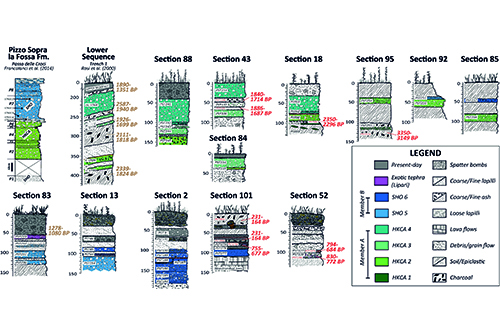Evolution of the eruptive activity at Stromboli (Aeolian Islands – Italy) during the last 4 millennia. A tephrostratigraphic investigation on the early-phase of Recent Stromboli Eruptive Epoch

Re G., A. di Roberto,P. del Carlo, M. Pompilio, (2025).
Journal of Volcanology and Geothermal Research, 462, 108308. https://doi.org/https://doi.org/10.1016/j.jvolgeores.2025.108308
Abstract
Stromboli is famous for its persistent explosive activity that has been studied from various perspectives over the last century. By contrast, there is controversial information about the volcanic history regarding the period between 6000 years ago and the onset of the present-day activity.
Here, we present a comprehensive tephrostratigraphic investigation of the pyroclastic sequences that predate the onset of the present-day activity. This study integrates field observations, sedimentological analyses and radiometric 14C dating, together with detailed textural, petrographic and geochemical characterisation of juvenile clasts. Specifically, we document two superimposed volcaniclastic sequences, Member A and Member B, consisting of sub-conformable pyroclastic beds of lapilli and ash, interspersed with massive epiclastic deposits. While these sequences exhibit similar lithological features, indicating comparable eruptive dynamics, they are distinguishable for glass composition and chronostratigraphic framework.
In particular, a major change in the glass composition of the magma occurred after 1780 years ago, with a shift from high-K calc-alkaline (HKCA) to shoshonitic (SHO) affinity, composition that still persists in the present-day. We recognise four distinct eruptive periods with HKCA composition within Member A and two eruptive periods with SHO composition within Member B, both predating the onset of the present-day activity. Also, within Member A, we observed the earliest coexistence and mingling of two end-members with different texture and composition. This suggests that the feeding system of Stromboli could have been very similar to the present-day since at least 3200 years ago. It likely comprises two distinct magma bodies at different depths containing magmas with different compositions and porphyritic characteristics that occasionally interact prior to eruptions.
Our findings contribute to a comprehensive reconstruction of Stromboli’s volcanic history and hold practical significance for anticipating and mitigating potential future volcanic events.



Devi effettuare l'accesso per postare un commento.